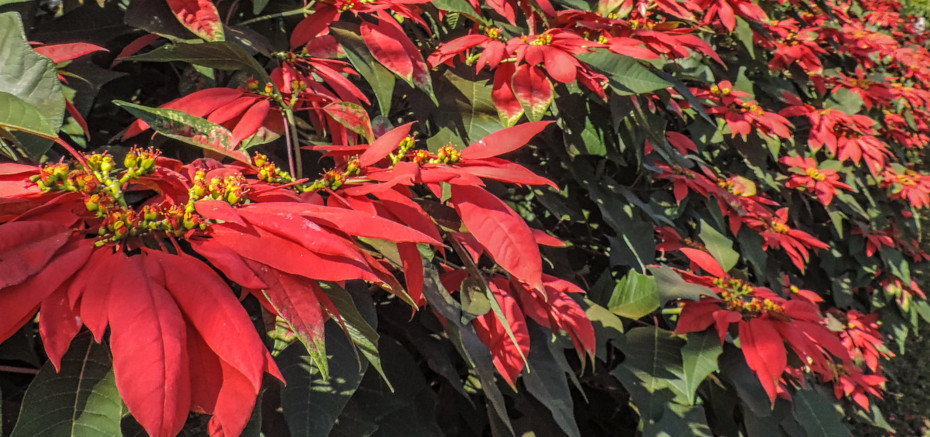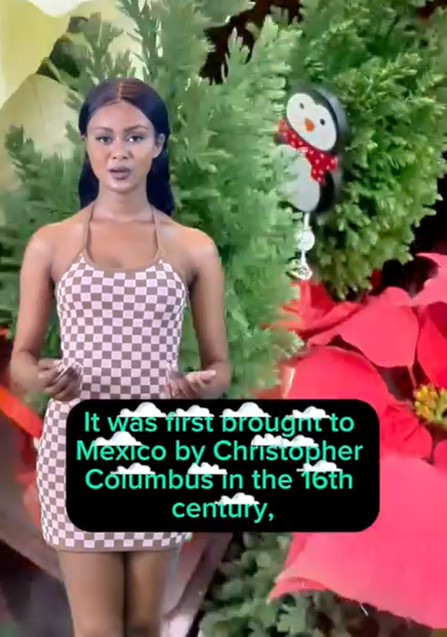The grade school I attended was within walking distance from my home, just over a mile. During my ½ hour walk in the morning and after school, I traveled through an older part of town that was very different from my post WWII neighborhood.
Their gardens were more mature and quite varied. Often unusual food plants were being grown along with other treasured fragrant flowers and useful herbs. One plant that was somewhat common was the poinsettia.
Its distinctive, tall, often leggy shape made it stand out even when it was not ‘in bloom’. Mid-way through the fall school semester, these would start producing their red bracts (colored leaves) surrounding the tight cluster of small yellow flowers, lasting through the holidays and into New Year.
I looked forward to this seasonal marker each year and enjoyed watching it develop day by day. The bright red color stood out in the otherwise somber fall/winter landscape, being one of the few plants that put on a show during these months.

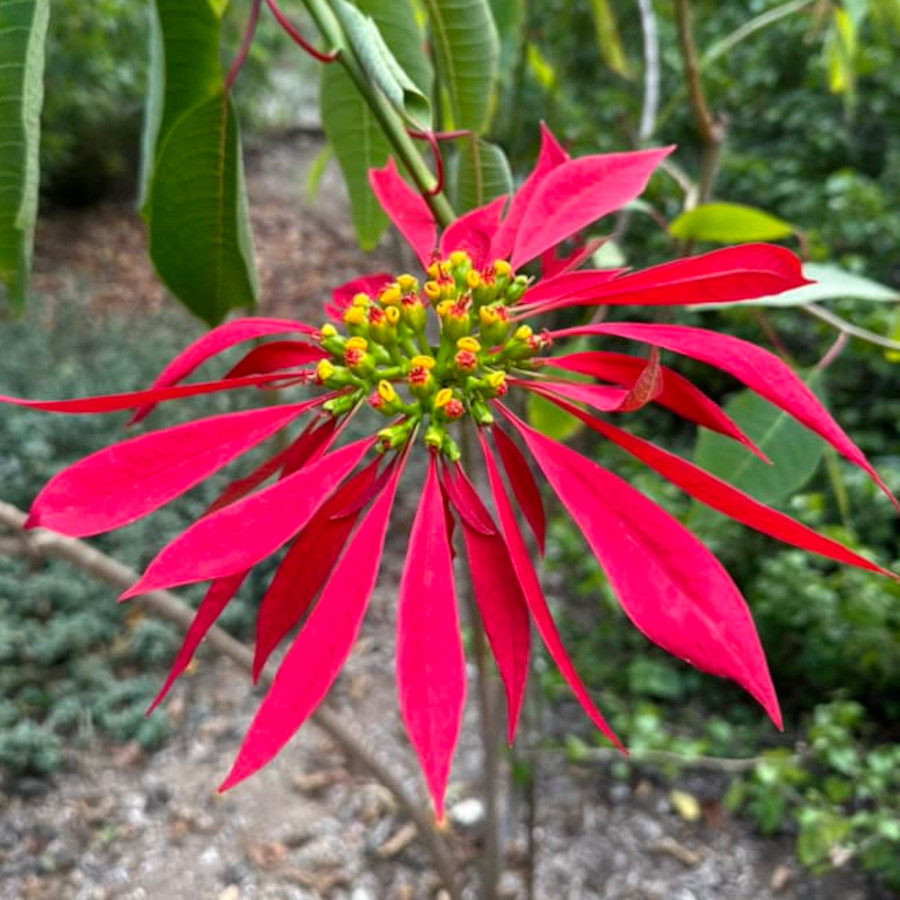
At this time, the mass production of potted poinsettias was not so ubiquitous in our part of California as it is today. The garden specimens seemed to have been planted by Mexican families (whose families may have been here since before California became part of the US) or immigrants from Central America, where the plant is also native.
When I thought of writing this piece, I started having second thoughts about researching a plant that today is something of a Christmas cliché. Boy was I wrong! I found so many interesting things related to poinsettias it was hard to know how to reign it in and stay on topic (something I’ve been known to have trouble with!). Regardless of those efforts, be warned that this is a long article!
Some Early History
During the 14th-16th centuries, the Aztecs highly prized this native plant medicinally and as a red/purple dye plant. In their language, Nahuatl, it’s name was ‘cuetlaxochitl’ (“kwet-la-sho-she”).

In the 17th century, after the Spanish conquest of Central America, Franciscan friars in one small village started using cuetlaxochitl in celebrations of the Christian Nativity. No doubt that friars realized the this common roadside ‘weed’ was significant to the indigenous people. This became a new tradition which spread throughout the region and the Nahuatl cuetlaxochitl became known, in Spanish, as ‘la flor de Nochebuena’, or the ‘Christmas Eve flower.’
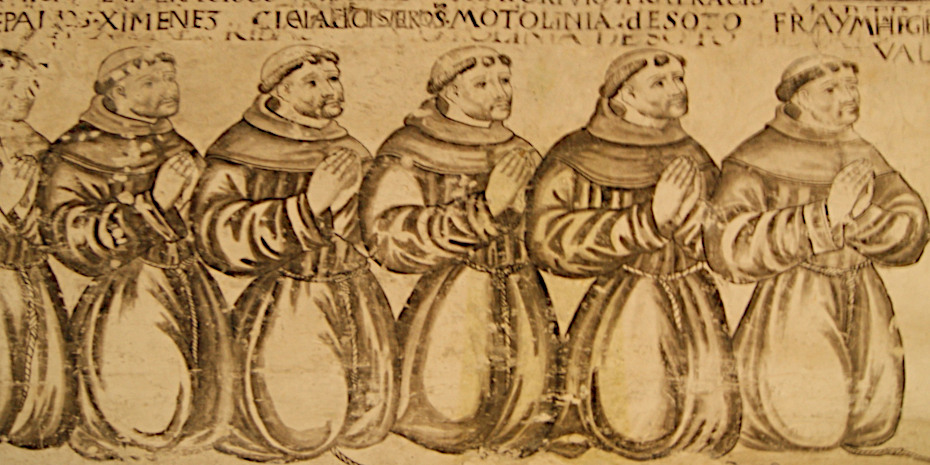
Enter Joel Roberts Poinsett (1778-1851). Between 1822-1829, US President James Monroe sent Poinsett on a diplomatic assignment to Mexico, and later, when the new Mexican Republic was recognized in 1824, President John Quincy Adams made him the U.S. Ambassador. While Poinsett apparently gained some affection for that country, writing about it’s culture, landscape, and plants, he seemed to lose the trust of its people and was even asked by them to leave! (The Mexican term ‘poinsettismo’ refers to North American interference in their nation’s affairs.)

Poinsett’s varied career is interesting (e.g. he was a co-founder of the Smithsonian Institution), but one interest in particular concerns us here – collecting plants. He sent seeds and plants back to the US and even grew ‘la flor de Nochebuena’ in his own Charleston, South Carolina greenhouse. He gifted the plants he grew to friends and colleagues. They were a big hit!
Bartram Botanic Garden of Philadelphia, PA, claims to have been the first to have introduced this Central American plant to the trade, listed as Euphorbia pulcherrima in their catalog (this latin name was published in 1834). The latin name Poinsettia pulcherrima was published in 1836 but is not, at least now, accepted by Botanists. But somehow, ‘poinsettia’ became the common name by which most English speaking people know this plant.
Gradually, other growers started to raise poinsettias across the country, but it was in California’s mediterranean climate that it ultimately found a strong foothold. Local Hispanic gardeners were already growing this plant which had been brought up from its native land when California was part of Mexico. In the early 1900s, Albert Ecke (“eh-key”) from Germany settled his family in Southern California and began a dairy and vegetable farm. Later he turned the farm to flowers since there was less competition in that area, and the poinsettias became one of their crops.

While field grown poinsettias became popular in California, in colder climates, they still had to be grown in greenhouses. While there was some growing interest in the flower, it remained the somewhat leggy thing that was prone to flop over randomly. The Eckes were about to change all that.
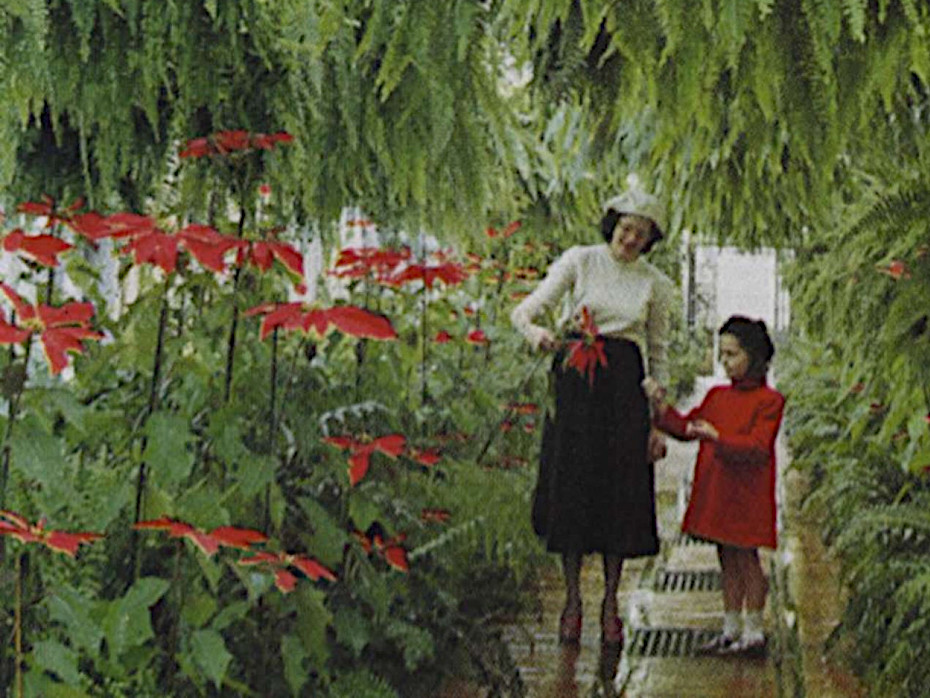
More about the Ecke Ranch ans poinsettias in More Recent History below.
A (perhaps not so) Brief Botany Break
Euphorbia pulcherrima Willd. ex Klotzsch in Allg. Gartenzeitung 2: 27 (1834)
ay-oop-HORE-bee-ah pulk-HER-ree-mah (pronunciation info)
Synonyms
Euphorbia coccinea Raf. in Atlantic J. 1: 182 (1833), nom. provis.
Euphorbia diversifolia Willd. ex Boiss. in A.P.de Candolle, Prodr. 15(2): 71 (1862)
Euphorbia erithrophylla Bertol. in Nuovi Ann. Sci. Nat. 1: 414 (1838)
Euphorbia fastuosa Sessé & Moc. in Naturaleza (Mexico City), ser. 2, 1(App.): 81 (1888)
Euphorbia lutea Alam. ex Boiss. in A.P.de Candolle, Prodr. 15(2): 72 (1862)
Euphorbia poinsettiana Buist ex Graham in Edinburgh New Philos. J. 20: 412 (1836)
Euphorbia poinsettii Raf. in Atlantic J. 1: 182 (1833), nom. provis.
Pleuradena coccinea Raf. in Atlantic J. 1: 182 (1833)
Poinsettia ignescens Van Geert in Nursery Cat. (Auguste Van Geert) 83: 20 (1882)
Poinsettia mirabilis Van Geert in Nursery Cat. (Auguste Van Geert) 83: 20 (1882)
Poinsettia pulcherrima (Willd. ex Klotzsch) Graham in Edinburgh New Philos. J. 20: 412 (1836)
Poinsettia variabilis Van Geert in Nursery Cat. (Auguste Van Geert) 83: 21 (1882)
The genus Euphorbia named after Euphorbus, Greek physician to the reputed discoverer of the plant, Juba II of Mauretania (1st century BC). The species epithet pulcherrima comes from the Latin adjective pulcher, meaning “beautiful”.
Euphorbia pulcherrima is native to the Pacific slope of Mexico and Central America, though it has now become naturalized further south and in dry tropical climates around the world. Studies have shown that most of the commercial forms grown trace their DNA to specific populations in Southern Mexico. The species appears to be a highly variable plant and some forms are far less showy and might have little resemblance to the plants we buy each year for the holidays.
The genus Euphorbia is one of the largest (about 2,000 species) of the flowering plants, all sharing the same weird flower arrangement called a cyathium, which includes a cup-like involucre, made up of fused bracts, holding highly reduced male and/or female flowers and one or more nectar glands. Seldom very large, these details are hard to see with the naked eye. A number of species have showy, colored bracts or modified leaves (as is the case with poinsettia) surrounding a cluster of flowers to help attract pollinators.

Speaking of these flowers, there is something you should know about when the plant produces them. When the darkness of night becomes about 14 hours long, and continues for 8 weeks, the plant starts producing flowers. Out in a field or in the countryside where it is native, this happens naturally after the autumnal equinox. But grown in or near cities that have buildings or streets lights during the night, the plant may fail to flower. Growers can and often do manipulate this period of darkness to force the plants to flower to meet their production deadlines, making it possible to flower plants to suit their needs.
Poinsettia is also known in its native lands as ‘Noche Buena’ (“Christmas Eve”, Mexico), and ‘Hoja de Pascua’ (“Easter leaf”, Guatemala). Names in other countries where it has become popular include ‘Burning Bush’ (Bermuda), ‘Xmas Star’ (Canary Islands, Solomon Islands), ‘Euphorbe de Noel’ (“Christmas Euphorbia”, France), ‘Paskwa’ (“Easter”, Philippines), ‘Flores de Pascua’ (“Easter Flowers”, Spain).
Because some of the exploits of Joel Roberts Poinsett are seen today as imperialist, racist, and just down right immoral by today’s standards, the common name of ‘poinsettia’ is considered inappropriate by some. Most of the other common names refer to a religious holiday in December, so there is a push to adopt the original Aztec name of cuetlaxochitl (“kwet-la-sho-she”), but this cumbersome mouthful would seem a ‘hard sell’ to other people around the world!
Growing Poinsettias in a garden
Why even bother to grow Euphorbia pulcherrima in the garden? There are so many diverse reasons gardeners choose to grow plants – food, culture, memories, aesthetics, challenges. Who can say? In spite of the ubiquity of flowering poinsettias during the holidays, perhaps you’d like your own.
Euphorbia pulcherrima is not difficult to grow, though it requires a relatively frost-free climate. Many places in the San Francisco Bay Area seldom experience frosts, and if they do, it is brief. Top growth of E. pulcherrima can badly ‘frosted’ during such events but it generally comes back from the roots or basal branches. Plants can get leggy and spindly so regeneration by cold or pruning can actually create a bushier plant.
Good drainage is important as E. puclherrima resents being wet & cold roots. Avoid heavy clay and/or plant on a slight slope. Morning sun and possible an overhanging roof or tree are also best if your area might be more prone to frosts. Be aware that streetlights or automatic security lights nearby might interrupt the 14 hours of darkness needed to induce flowering (see Botany Break above).
In rare cases, usually with some assistance, E. pulcherrima can assume height and become a small tree, as it does in its homeland.
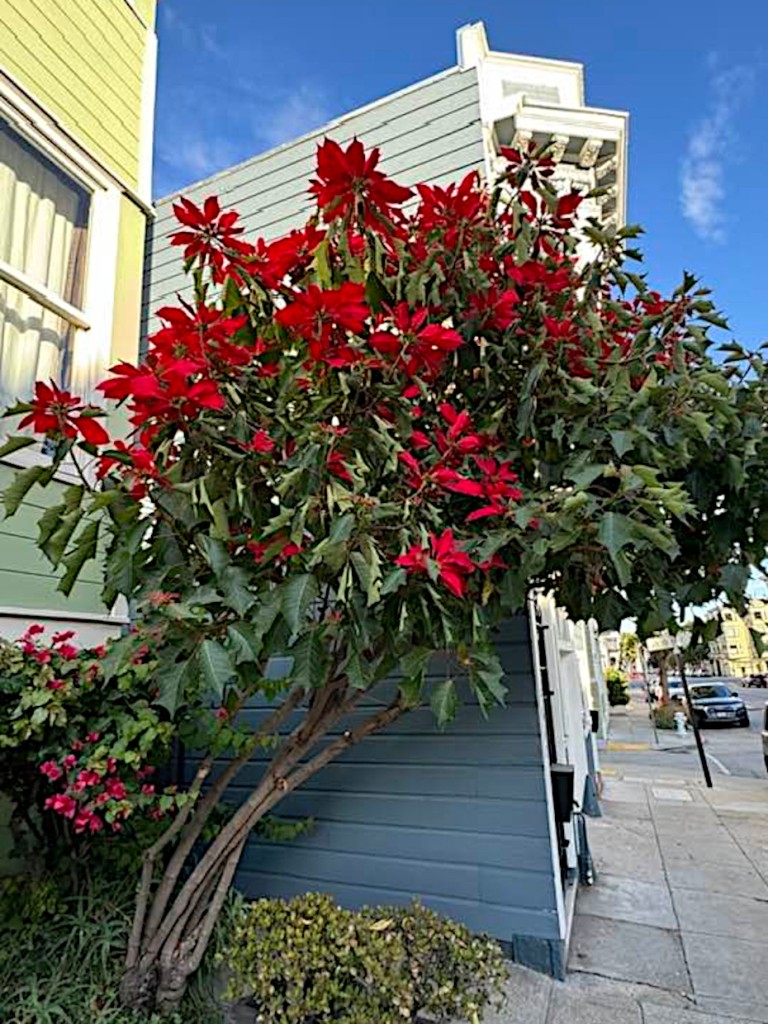
Sometimes the commercial treatments of growing potted E. pulcherrima for the holidays makes growing them on in the garden somewhat difficult if not impossible. Larger plants seems to establish in the garden better than smaller. It is worth noting that some new commercial varieties are selected for their dwarf characteristics.
Not much is written about growing this plant in our local area (it grows much more easily in Southern California, which also requires little to be written!). Maybe the best source is talking to someone who is actually growing it successfully in your area. Gardeners generally enjoy talking about the plant they grow – just ask!!
Caring for Your Potted Poinsettia
A lot has been written about caring for potted E. pulcherrima. Rather than repeat that information here, I provide some good references:
Poinsettia – La Flor de Nochebuena
Poinsettia Care
Guide to Selection and Care of Poinsettias
Poinsettia Care – How Do You Take Care Of Poinsettias
More Recent History
Continuing from Some Early History.

California’s mediterranean climate showed great promise for growing the poinsettia, especially in the southern part of the state. The open fields of the flower became something of a tourist attraction late in the year. Ecke Ranch first it was offered as a cut flower, which did well, but the blooms were relatively short-lived by today’s standards.
Ecke Ranch came up with the idea of promoting the poinsettia as a ‘Christmas Flower’ since there was no specific flower associated with that season in the US at the time. Growing the plant in the ground in the open air was quite successful in the relatively frost-free Southern California. Their first farm was in the Hollywood area, but in 1923, as the film industry encroached on their fields, they moved their operation 100 miles (160 km) south to Encinitas, on the Pacific coast just North of San Diego.

When Paul Ecke I took over the business from his father Albert, he promoted the poinsettia in earnest and even helped found the American Florists’ Exchange. People started calling him “Mr Poinsettia”. Growing thousands of field-grown plants produced allowed for Ecke to spot various mutations that produced poinsettias with better form. In the 1930s, when trademarking plants became possible, Ecke protected many of his varieties.

Paul Ecke II encouraged raising poinsettias in greenhouses as well as selective breeding programs to produce better varieties. Scientific research and test on the plant helped improve the understanding of how best to grow them. Ecke Ranch also pioneered a propagation technique to produce compact, well-branched plants that would make a nice display as a potted plant (which produced the type of plant we see today) which was a closely guarded company secret.
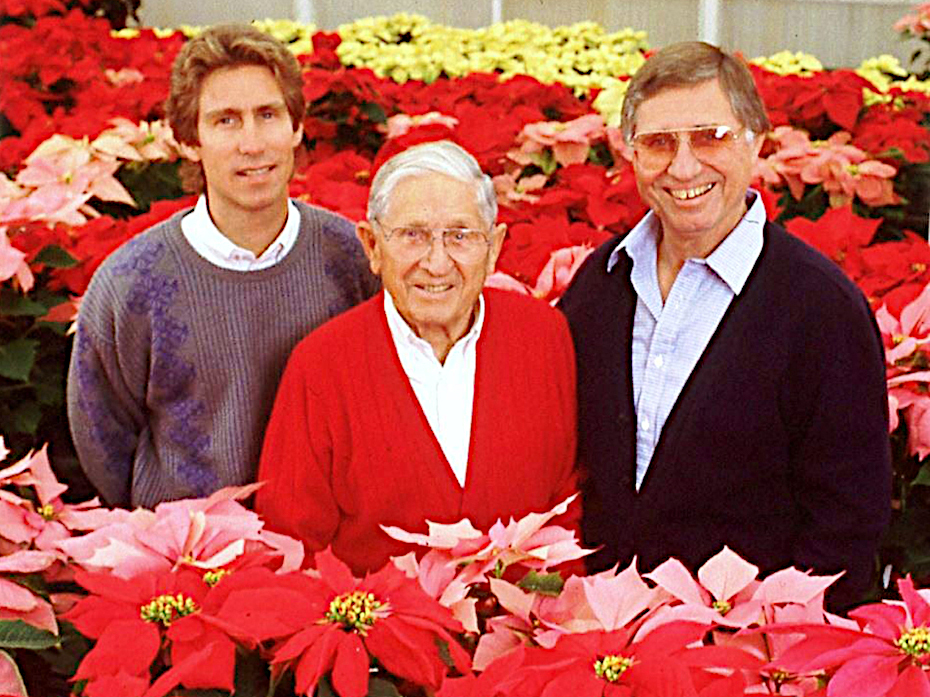
In the 1960s, Ecke started selling potted plant locally as well as shipping them across the US. His son, Paul Ecke II, came up with the idea of shipping cuttings to growers who would produce the potted plant, saving on shipping costs. This made it possible for Ecke Ranch to become an important supplier nation-wide while protecting their monopoly.
Paul Ecke II handled most of the marketing for the business when he started working with his father. He was able to bring poinsettias to the attention of the general public through print and television media. He was able to get Ecke Ranch poinsettias into a Sunset Magazine holiday issue (produced in the summer) by artificially controlling the light conditions in a greenhouse (provide 14 hours of darkness each night) to induce flowering plants ahead of the normal schedule. Paul II sent poinsettias to celebrities and magazine editors. Once some media outlets started featuring poinsettias the others wanted in on the action!

In 1991, Paul Ecke III took over the company. In 1992, he noticed an article published in American Society for Horticultural Science outlining the actual ‘secret’ grafting technique his company was using to produce their compact plants!! (the basic idea seems to be grafting a production variety onto a plant that is infected with a bacterium which then infects the grafted plant forcing it to branch more freely) Their secret was out and it was soon picked up by numerous competitors around the world.
In December 2004, Huell Howser interviewed Paul II & Paul III on an episode of California Gold (video archive at Chapman University).
Ecke Ranch was no longer the industry leader. Paul Ecke III own son had other career plans of his won, so there was no one to inherit the company. In August 2012, the Ecke family sold their nearly 100 year-old company to the Dutch Agribio Group, which in 2013 merged with the German company Dümmen Group, the European market leader for poinsettia cuttings and young plants.

Each year, some new colors and unusual forms make their debut. It can be somewhat confusing and overwhelming, and finding a particular form on demand can be near impossible. Cuttings of these types were provided to growers months ahead of time for them to grow their crops in time for the holidays. Once the plants are sold, these growers have typically moved on to producing another seasonal plant (i.e. they are not like your typical garden plant nurseries).

Recently, Mexico has proclaimed December 7th to be a special day to honor cuetlaxochitl (in the US, Dec 12th is a day to honor poinsettia, which is also the day Joel Roberts Poinsett died). Mexican botanists and growers are keen to develop their own forms of their native cuetlaxochitl (Euphorbia pulcherrima). One reason is that US copyright laws apparently prohibit American cultivars from being grown outside of the US. Another would be the cost and dependence of purchasing American forms. It will be interesting to see what plants this south-of-the-border effort produces in the coming years.

Internet Inconsistencies
The white sap of Poinsettias is highly toxic to humans and their pets.
While it is true that the sap of this plant can cause dermatitis in some people, studies have shown that this claim has no foundation.
There was a very strange Facebook ‘reel’ circulating on the Internet while I was writing this article, obviously created using AI, entitled “Unveiling the Poinsettia: A Festive Symbol of the Season“, whose stated aim is to provide the ‘true facts’ about poinsettias. Some of these include Christopher Columbus brought the poinsettia to Mexico in the 16th century (the closest he got to Mexico was Honduras), that the real botanical name is Euphorbia tirucalli (a very different looking species), and the Euphorbia family contains other plants such as the banana and the sand dollar, (and here I thought they were in the banana plant family Musaceae and the ANIMAL family Echinarachniidae respectively).
My head still hurts from watching it!!
The red and green color theme comes from the colors of the poinsettia plant.
If any plant might be responsible for our end of the year holiday color theme, it would be the holly (Ilex sp.), an evergreen tree which bears shiny green leaves and red berries through the winter, often considered as a sign of eternal life since the middle ages or before. (and the poinsettia was unknown to Europeans until they discovered the Western continent of America)
In 1935, an American professor created a new form of poinsettia and named it for Kemal Atatürk (1881-1938), was the founder and first president (1923–38) of the Republic of Turkey.
I discovered this tidbit while researching some common names for poinsettias around the world. Intrigued, I did the research. The whole thing still remains a bit hinky, and there are many, many variations, but here is a summary of some of it:
In 1935, there were various short bits in some Turkish newspapers. Each had slightly different ‘facts’ and spellings of American persons and entities. Chicago is mentioned in conjunction with Vanderbilt University (which is in Kentucky). A professor named ‘Kurt Landin’ or ‘Kirklind’ is said to be the creator of this new form (James Hampton Kirkland (1859-1939) was an American Latinist and the 2nd university administrator of Vanderbilt). Vanderbilt also has a Kirkland Hall around which James Kirkland created an arboretum (i.e. there is no ‘Kirkland Laboratories’ as stated in the Turkish newspapers). James Kirkland was known to enjoy growing Iris but the Vanderbilt archivists find no mention him dabbling in poinsettias.
The Turkish missives also mention that there was another professor at Vanderbilt who had actually met Kemal Atatürk and suggested that the new poinsettia be named for him. Curiously, there was a 1933 article written by Vanderbilt professor W.A. Harper, entitled The Gazi of Turkey, about the life of Atatürk, the new Turkish Republican leader.
There is no record or evidence of a E. pulcherrima ‘Atatürk’ or ‘Gazi Atatürk’ cultivar.
A few of Turkish write-ups about poinsettia being named for Atatürk talk about his love for the natural world and suggest he admired the plant and brought it to Turkey. Atatürk’s appreciate of nature is well-documented so this seems more plausible than the Vanderbilt connection (which seems like it might have been a ploy to promote “the friendship between the two nations”). And certainly the red color of the poinsettia echos the chosen color of the new republic’s flag!
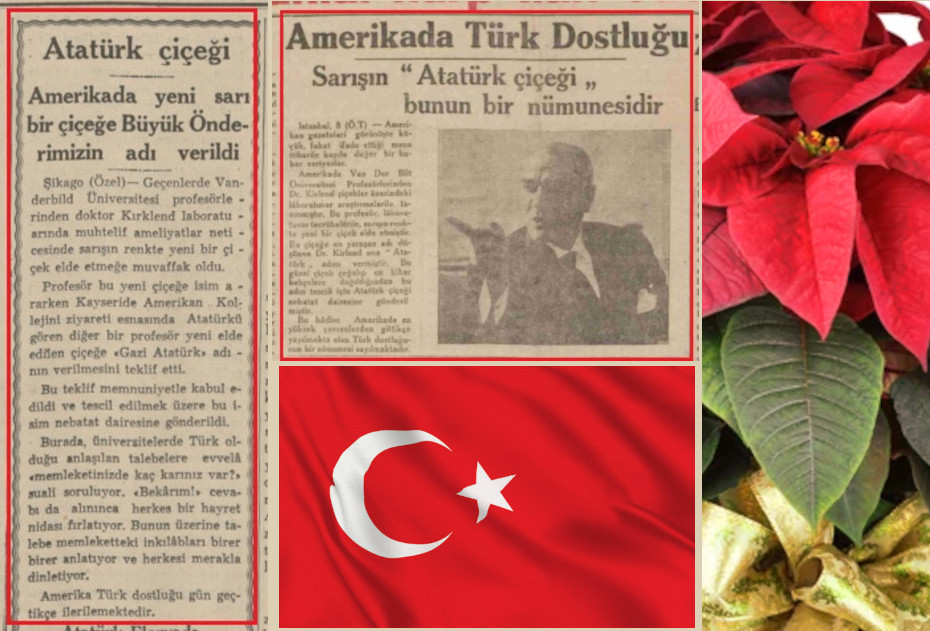
References and Links
(*Information retrieval date for the URL mentioned)
Trejo, Arroyo, Olsen, Eguiarte, Arroyo, Gruhn, and Olson. Poinsettia’s wild ancestor in the Mexican dry tropics: Historical, genetic, and environmental evidence. American Journal of Botany. July 2012.
https://bsapubs.onlinelibrary.wiley.com/doi/full/10.3732/ajb.1200072 (*October 2023)
Grace, Maestra. Cuetlaxóchitl, a Gift of Light from Mexico. Curanderismo, the Healing Art of Mexico. Dec 2021.
https://www.curanderismo.org/post/cuetlaxochitl-poinsettia-a-gift-of-rebirth-and-light-from-mexico (*December 2023)
Mann, Kristin Dutcher. Christmas in the Missions of Northern New Spain. The Americas, Vol. 66, No. 3, January 2010, pp. 331-351. Cambridge University Press.
https://www.jstor.org/stable/25602444 (*November 2023)
Euphorbiaceae. Wikipedia.
https://en.wikipedia.org/wiki/Euphorbiaceae (*September 2023)
California State University, San Marcos. Preserving the History of the Poinsettia. Nov 2018.
https://news.csusm.edu/ecke-collection/ (*October 2023)
McNamara, Robert. Biography of Joel Roberts Poinsett. July 2019
https://www.thoughtco.com/joel-roberts-poinsett-4118566 (*August 2023)
Encyclopaedia Britannica, Editors. Escocés and Yorkino: Mexican political organization. October 2006
https://www.britannica.com/topic/Escoces (*November 2023)
Hoddle, Mark. Aztecs, Ambassador Poinsett, and Poinsettia. University of Massachusetts. December 2016.
https://ag.umass.edu/greenhouse-floriculture/fact-sheets/aztecs-ambassador-poinsett-poinsettia (*October 2023)
Paul Ecke Ranch. Wikipedia.
https://en.wikipedia.org/wiki/Paul_Ecke_Ranch (*November 2023)
Wagner, Davia, and Hayden, Sara. SFGate. Ecke family made poinsettias a holiday tradition: How an immigrant family in the 1900s turned the poinsettia into ‘the Christmas flower’. Nov 2011
https://www.sfgate.com/homeandgarden/article/ecke-family-made-poinsettias-a-holiday-tradition-2324348.php (*September 2023)
Hendry, Erica R. How America’s Most Popular Potted Plant Captured Christmas. Smithsonian Magazine. Dec 2013.
https://www.smithsonianmag.com/arts-culture/how-americas-most-popular-potted-plant-captured-christmas-180949299/ (*September 2023)
Flynn, Sheila. The path of poinsettias: How the distinctive red-and-green plants became festive favorites across the US – thanks to a tireless campaign by a California family who dominated the market for decades. December 2017.
https://www.dailymail.co.uk/news/article-5207307/How-one-family-helped-make-poinsettias-Christmas-staple.html (*November 2023)
Beltz, Betsy. The Poinsettia: An Evolving Tradition. Longwood Gardens. December 2020.
https://longwoodgardens.org/blog/2020-12-09/poinsettia-evolving-tradition (*October 2023)
Kohfeld, Mike. Cuetlaxochitl: A Cultural History of the Poinsettia. Swansons Nursery. November 2021.
https://www.swansonsnursery.com/blog/history-of-poinsettias (*October 2023)
The Garden Trust. A touch of festive red… December 2014.
https://thegardenstrust.blog/2014/12/20/a-touch-of-festive-red/ (*November 2023)
Dole, John M, and Wilkins, Harold F. In Vivo Characterization of a Graft-transmissible, Free-branching Agent in Poinsettia. American Society for Horticultural Science. Volume 117, Issue 6, Nov 1992.
https://journals.ashs.org/jashs/view/journals/jashs/117/6/article-p972.xml?tab_body=pdf (*July 2023)
Graper, David. Are you Photoperiodic? Poinsettias Are. South Dakota State University Extension. December 2018
https://extension.sdstate.edu/are-you-photoperiodic-poinsettias-are (*November 2023)
Candeias, Matt. Poinsettias Wild Origins. December 2017.
https://www.indefenseofplants.com/blog/2017/12/26/poinsettias-wild-origins (*July 2023)
Cesáreo, Javier Salinas. Investigadores de Chapingo obtienen siete variedades de la flor de nochebuena. Periódico La Jornada, 4 diciembre 2022, p.22.
https://www.jornada.com.mx/2022/12/04/estados/022n2est (*November 2023)
Atatürk çiçeği. Wikipedia.
https://tr.wikipedia.org/wiki/Atat%C3%BCrk_%C3%A7i%C3%A7e%C4%9Fi (*November 2023)
Harper, W.A. The Gazi of Turkey. The Journal of Religion. January 1933.
https://www.journals.uchicago.edu/doi/epdf/10.1086/481274 (*October 2023)
